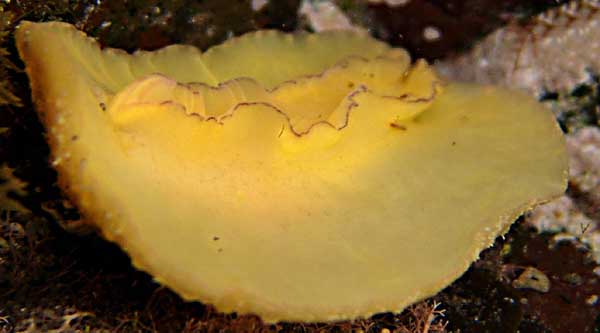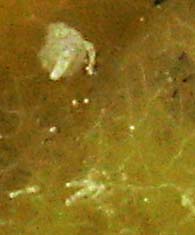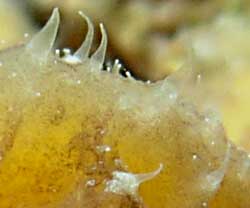This species has been observed on Reunion and Mayotte Islands
Species characteristics : A dull, brown or yellowish colour with creamy white area and with a firm, sponge-like mantle. The animal is oval in outline, the outer region of the dorsum is flattened and the central region forming a high ridge. The long tapering papillae at the tip of many of the tubercles are a good character of this species. |
 |
|
| Showing species characteristics... | Photo Philibert Bidgrain Reunion, Etang salé lagoon, less 1 m, 3 February 2007, size : 30-35 mm |
|
See more about : Sightening and mating periods
See more about : Sclerodoris apicula variability in Southwest Indian ocean
Remarks :
Identification confirmed by Bill Rudman and Nathalie Yonow
Synonymous : (according Worms)
- Doris apiculata, Alder & Hancock, 1864
- Halgerda apiculata, (Alder & Hancock, 1864)
Bibliographic data :
All over the dorsum are scattered conical tubercles, the largest of them being on the sides of the central ridge.
The tubercles are connected by a network of ridges which in the central region are quite sharply angled but on the flat outer region they are more rounded and sometimes difficult to distinguish. From the tip of each tubercle projects a long fleshy papilla which is able to be completely withdrawn into a socket at the tip of each tubercle.
The dorsum has a smooth soft feel, not rough to touch like Platydoris.
In some specimens there are also a few very dark, almost black, markings. These are on the flattened part of the dorsum.
The rhinophore pockets are raised and the edge crenulate. Each crenulation is white with a dark brown base. The rhinophore stalk is a watery brown and the lamellate club is creamy yellow-brown with dark brown and white streaks along the edge of the lamellae.
The gill pocket is slightly raised and partially subdivided so that each gill branch has its own bay. The gills are bushy and tripinnate. The main rachi are transparent watery-brown with white patches, and the secondary and tertiary rachi are white with transverse streaks of dark brown. The gill pinnules are whitish with white and dark brown speckling. They have six or seven gills.
The underside of the mantle and the side of the foot are yellow-brown with darker brown patches on the side of the foot and the inner half of the mantle. The outer half of the underside of the mantle has some brownish marks showing through from the dorsal surface. The sole of the foot is creamy-yellow with no markings
It is found in mid-intertidal region, where it feeds on sponge.
References :
Bill Rudman Seaslug site : Sea Slug Forum : Sclerodoris apiculata
Nudipixel Sclerodoris apiculata
Publications :
Alder, J. & Hancock, A. (1864). Notice of a collection of nudibranchiate mollusca made in India by Walter Elliot Esq., with descriptions of several new genera and species. Transactions of the Zoological Society of London , 5 : 113-147.
Rudman, W.B. (1978) The dorid opisthobranch genera Halgerda and Sclerodoris from the Indo-West Pacific. Zoological Journal of the Linnean Society 62 : 59-88.
Other photos of Sclerodoris apiculata :
 |
In some specimens there were on the flattened part of the dorsum, a few very dark, almost black, markings. The rhinophore pockets are raised and the edge crenulate.  |
Philibert Bidgrain Reunion, Etang salé lagoon, less 1 m, 5 January 2007, size : 35 mm
In this specimen the underside of the mantle and the foot are white with darker brown patches on the side of the foot and the inner half of the mantle (a). The outer half of the underside of the mantle has some brownish marks showing through from the dorsal surface (b).
|
 |
 |
Philibert Bidgrain Reunion, Etang salé lagoon, less 1 m, 3 December 2009, size : 40 mm In this specimen, the underside of the mantle is white (b) and the side and the sole of the foot is creamy-yellow (a) with darker brown patches on the side of the foot and the inner half of the mantle. The outer half of the underside of the mantle has some brownish marks showing through from the dorsal surface. 
|
Philibert Bidgrain Reunion, Etang salé lagoon, less 1 m, 12 January 2005, size : 40 mm
|  |
 |
Hugues Flodrops Reunion, Etang salé, on the rocky coast, less 1 m, 1 February 2009, size : 15-18 mm. One juvenile form In this specimens there were on the flattened part of the dorsum, a few very dark, almost black, markings. |
Christophe Cadet Reunion, Etang salé, on the rocky coast, less 1 m, 19 October 2009, size : 30 mm. According Nathalie Yonow : A very strange yellow form... |
 |
 |
From the tip of each tubercle projects a long fleshy papilla which is able to be completely withdrawn into a socket at the tip of each tubercle.  |
In this specimen, all the underside of the mantle and the foot are creamy-yellow. The sole of the foot is creamy-yellow with no markings by with a dark margin
|
 |
 |
Philibert Bidgrain Reunion, Etang salé lagoon, less 1 m, 24 March 2010, size : 20 mm A very strange yellow form... From the tip of some tubercle projects a long fleshy papilla  |
We found this "yellow form" in a hole (see upper photo), and in the hole there is a yellow spawn.... May be its spawn???... We need other photo to confirm this observation... In this specimen, all the underside of the mantle and the foot are creamy-yellow. The sole of the foot is creamy-yellow with no markings by with a dark margin |
 |
 |
Christophe Cadet Reunion, Saint Leu lagoon, less 1 m, 30 January 2010, size : 30 mm A very strange specimen with hole on the notum like some S. tuberculata but with long fleshy papilla characteristic of S. apicula
|
 |
 |
Christophe Cadet Reunion, Saint Leu lagoon, less 1 m, 30 January 2010 Three specimens with a spawn... Sclerodoris apicula or Asteronotus cespitosus spawn??? We usually found these two species under the same rock with this kind of spawn.... So we need a photo of an active spawn event for tis species.... |
Philibert Bidgrain Reunion, La Saline lagoon, less 1 m, 17 April 2010, size : 25 mm  |
Specimen with an important among of long tapering papillae The gill pocket (a) is slightly raised and partially subdivided so that each gill branch has its own bay. The gills are bushy, tripinnate (1,2 and 3) and around the anus (b)  |
 |
Philibert Bidgrain Reunion, Etang salé lagoon, less 1 m, 25 September 2004, size : 35 mm With a Sagaminopteron psychedelicum
|
Philibert Bidgrain Reunion, Etang salé lagoon, less 1 m, 25 September 2004, size : 35 mm Important network of rounded ridges.  |
 |
 |
Remy Eudeline Mayotte, sakouli lagoon, less 1 m , 16 November 2017 In some specimens there were on the flattened part of the dorsum, a few very dark, almost black, markings.
|
More photos from Indian Ocean
See more about : Sclerodoris apiculata variability in Southwest Indian ocean
Reunion, Sclerodoris apiculata with black markings on the notum, at Etang salé, by Christophe Cadet
Reunion, Sclerodoris apiculata meet a pink spawn, at Etang salé, by Philibert Bidgrain
Reunion, Sclerodoris apiculata with a small Doriopsis, at Saint-Leu, by Christophe Cadet
Reunion, a small specimen of Sclerodoris apiculata, at Saint Leu, by Philibert Bidgrain
Reunion, a yellow of Sclerodoris apiculata, at Etang Salé, by Jean-Marie Gradot
Reunion, Sclerodoris apiculata, at La Saline, by Philippe Bourjon

